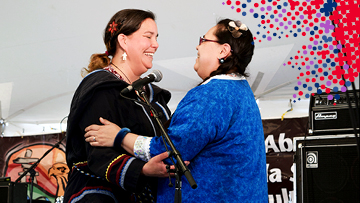Help spread the word about 2021 census data on Indigenous peoples in Canada. These data were released on September 21, 2022.
Quick facts
- The 2021 Census counted 1.8 million Indigenous people, now accounting for 5.0% of the total population in Canada, up from 4.9% in 2016.
- The Indigenous population grew by 9.4% from 2016 to 2021, surpassing the growth of the non-Indigenous population over the same period (+5.3%).
- For the first time, the Census of Population enumerated more than 1 million First Nations people living in Canada (1,048,405).
- In 2021, there were 624,220 Métis living in Canada, up 6.3% from 2016.
- In 2021, there were 70,545 Inuit living in Canada, with just over two-thirds (69.0%) living in Inuit Nunangat—the homeland of Inuit in Canada.
- The Inuit population living outside Inuit Nunangat grew at a faster pace than the population within the Inuit homeland (+23.6% versus +2.9%).
- The Indigenous population living in large urban centres—801,045 people—has grown by 12.5% from 2016 to 2021.
- The Indigenous population was 8.2 years younger, on average, than the non-Indigenous population overall.
- In 2021, 14.2% of Indigenous children lived with at least one grandparent, compared with 8.9% of non-Indigenous children.
- Indigenous people were more likely than the non-Indigenous population to be living in a dwelling that was in need of major repairs (16.4% versus 5.7%) or live in crowded housing (17.1% versus 9.4%) in 2021.
- In 2021, almost one in five Indigenous people in Canada (18.8%) lived in a low-income household, using the low-income measure, after tax. This was down nearly 10 percentage points from 2016. The decline was likely driven by government transfers in response to the COVID-19 pandemic.
- In Canada, 237,420 Indigenous people could speak an Indigenous language well enough to conduct a conversation.
Resources
- The Daily - Indigenous population continues to grow and is much younger than the non-Indigenous population, although the pace of growth has slowed
- Census in Brief - Housing conditions among First Nations people, Métis and Inuit in Canada from the 2021 Census
- Census in Brief - Membership in a Métis organization or Settlement: Findings from the 2021 Census of Population
- Video - 2021 Census: New Indigenous content
Social media content
Statistics Canada encourages our community supporters to share our content and images to their own social media accounts. You can save the images to your device and copy and paste the text content to your social media platforms.
Post 1
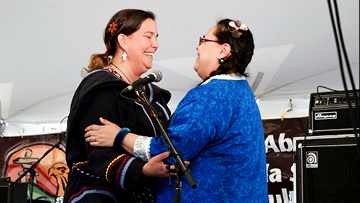
Suggested text:
Statistics Canada released the fifth series of results from the #2021Census which includes data on First Nations, Métis and Inuit populations in Canada.
To learn more: https://bit.ly/3RDCOGa
Post 2
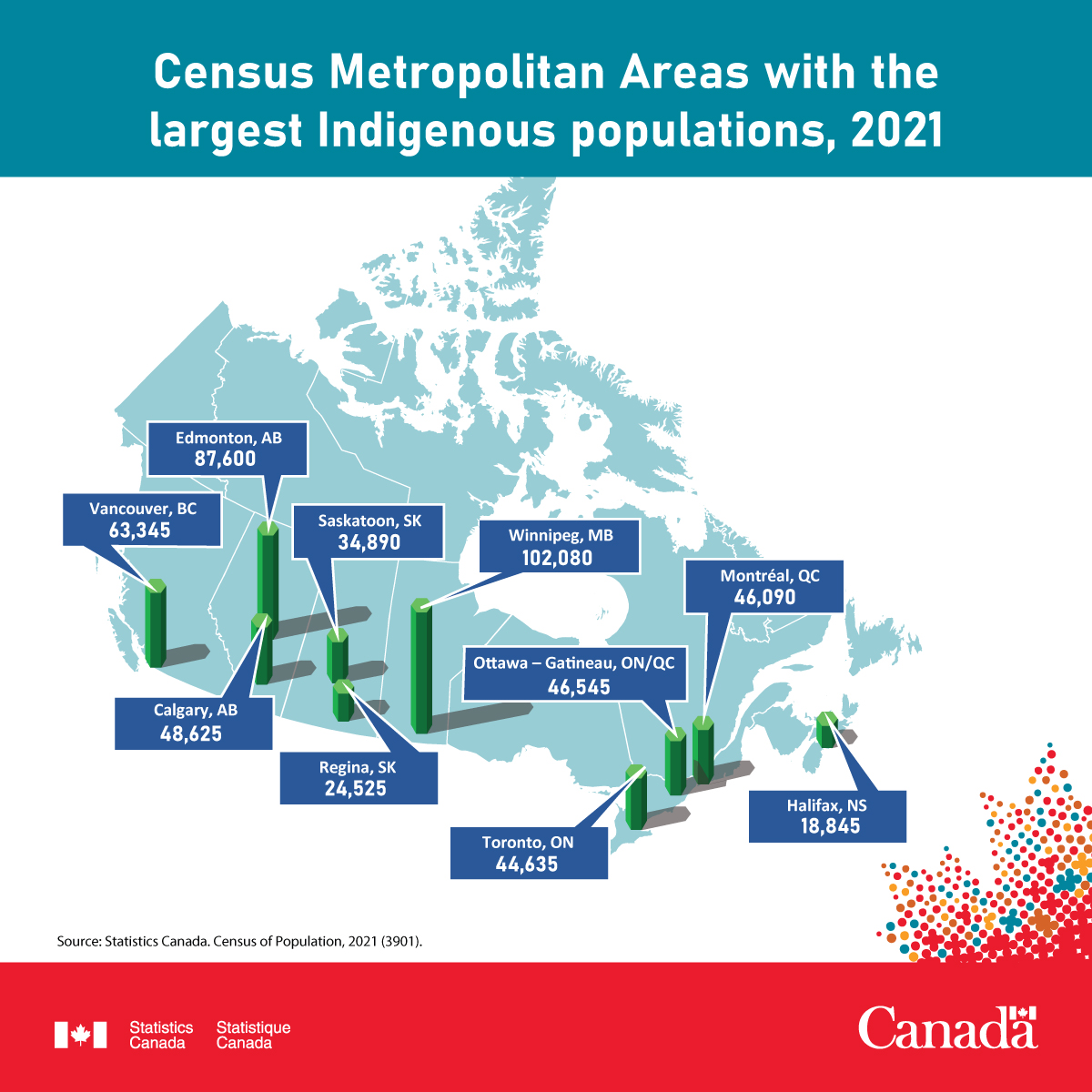
Alt text / description - Post 2 image
Census Metropolitan Areas with the largest Indigenous populations, 2021
This is a map of Canada showing the census metropolitan areas with the largest Indigenous populations in 2021.
For the 10 census metropolitan areas with the largest Indigenous populations, vertical bars indicate the size of the Indigenous populations.
The population count is presented as follows:
- Halifax, Nova Scotia, at 18,845;
- Montréal, Quebec, at 46,090;
- Ottawa–Gatineau, Ontario/Quebec, at 46,545;
- Toronto, Ontario, at 44,635;
- Winnipeg, Manitoba, at 102,080;
- Regina, Saskatchewan, at 24,525;
- Saskatoon, Saskatchewan, at 34,890;
- Edmonton, Alberta, at 87,600;
- Calgary, Alberta, at 48,625; and
- Vancouver, British Columbia, at 63,345.
Source(s): Census of Population, 2021 (3901).
Suggested text:
Did you know that #Winnipeg is home to largest Indigenous population in Canada?
Check out the latest data from the #2021Census to learn more: https://bit.ly/3BJNePq
Post 3
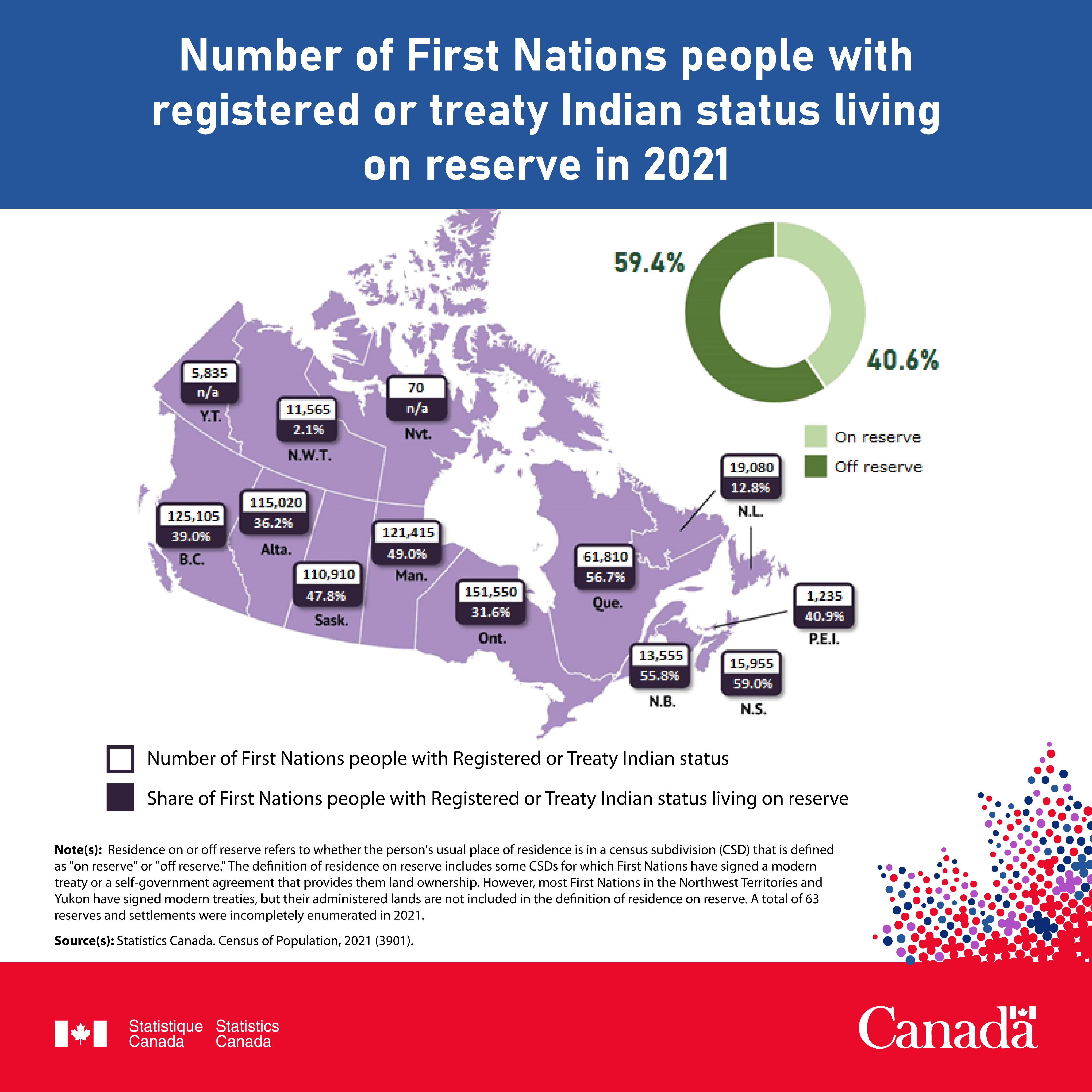
Alt text / description - Post 3 image
Number of First Nations people with registered or treaty Indian status living on reserve in 2021
This is a map of Canada by province and territory, showing the population counts of First Nations people with Registered or Treaty Indian status and the proportion of First Nations people with Registered or Treaty Indian status living on reserve in 2021.
In Canada, among First Nations people with Registered or Treaty Indian status, 40.6% were living on reserve and 59.4% were living off reserve in 2021.
In Alberta, the number of First Nations people with Registered or Treaty Indian status was 115,020, and 36.2% were living on reserve in 2021.
In British Columbia, the number of First Nations people with registered or treaty Indian status was 125,105, where 39.0% were living on reserve in 2021.
In Manitoba, the number of First Nations people with registered or treaty Indian status was 121,415, where 49.0% were living on reserve in 2021.
In New Brunswick, the number of First Nations people with registered or treaty Indian status was 13,555, where 55.8% were living on reserve in 2021.
In Newfoundland and Labrador, the number of First Nations people with registered or treaty Indian status was 19,080, where 12.8% were living on reserve in 2021.
In Nova Scotia, the number of First Nations people with registered or treaty Indian status was 15,955, where 59.0% were living on reserve in 2021.
In Northwest Territories, the number of First Nations people with registered or treaty Indian status was 11,565, where 2.1% were living on reserve in 2021.
In Nunavut, the number of First Nations people with registered or treaty Indian status was 70 in 2021, where the proportion living on reserve is not applicable.
In Ontario, the number of First Nations people with registered or treaty Indian status was 151,550, where 31.6% were living on reserve in 2021.
In Prince Edward Island, the number of First Nations people with registered or treaty Indian status was 1,235, where 40.9% were living on reserve in 2021.
In Quebec, the number of First Nations people with registered or treaty Indian status was 61,810, where 56.7% were living on reserve in 2021.
In Saskatchewan, the number of First Nations people with registered or treaty Indian status was 110,910, where 47.8% were living on reserve in 2021.
In Yukon, the number of First Nations people with Registered or Treaty Indian status was 5,835 in 2021, and the proportion living on reserve is not applicable.
Note(s): Residence on or off reserve refers to whether the person's usual place of residence is in a census subdivision (CSD) that is defined as "on reserve" or "off reserve." The definition of residence on reserve includes some CSDs for which First Nations have signed a modern treaty or a self-government agreement that provides them land ownership. However, most First Nations in the Northwest Territories and the Yukon have signed modern treaties, but their administered lands are not included in the definition of residence on reserve. A total of 63 reserves and settlements were incompletely enumerated in 2021.
Source(s): Census of Population, 2021 (3901).
Suggested text:
In 2021, 4 in 10 First Nations people with Registered or Treaty Indian status lived on reserve.
Find more data from the #2021Census at: https://bit.ly/3BJNePq
Post 4
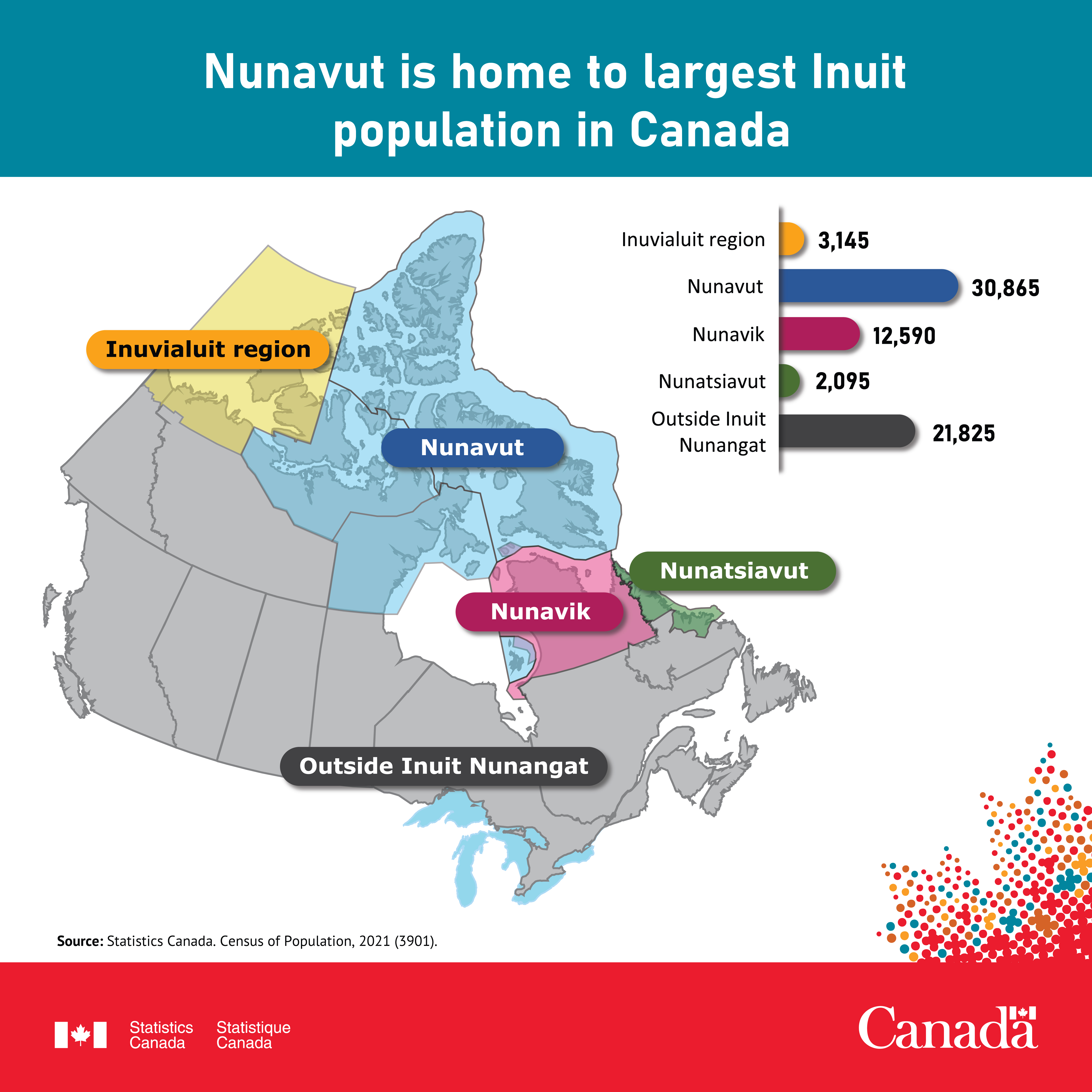
Alt text / description - Post 4 image
Nunavut is home to the largest Inuit population in Canada
This is a map of Canada showing the four regions of Inuit Nunangat and the area outside Inuit Nunangat, as well as the corresponding numbers of Inuit in these regions in 2021.
For the four regions of Inuit Nunangat and the area outside Inuit Nunangat, the numbers of Inuit are presented as follows: the Inuvialuit region at 3,145; Nunavut at 30,865; Nunavik at 12,590; Nunatsiavut at 2,095; and outside Inuit Nunangat at 21,825.
Source(s): Census of Population, 2021 (3901).
Suggested text:
The #2021Census counted 70,545 Inuit living in Canada. For more information on the Inuit population, visit Statistics Canada's website: https://bit.ly/3RDCOGa
Post 5
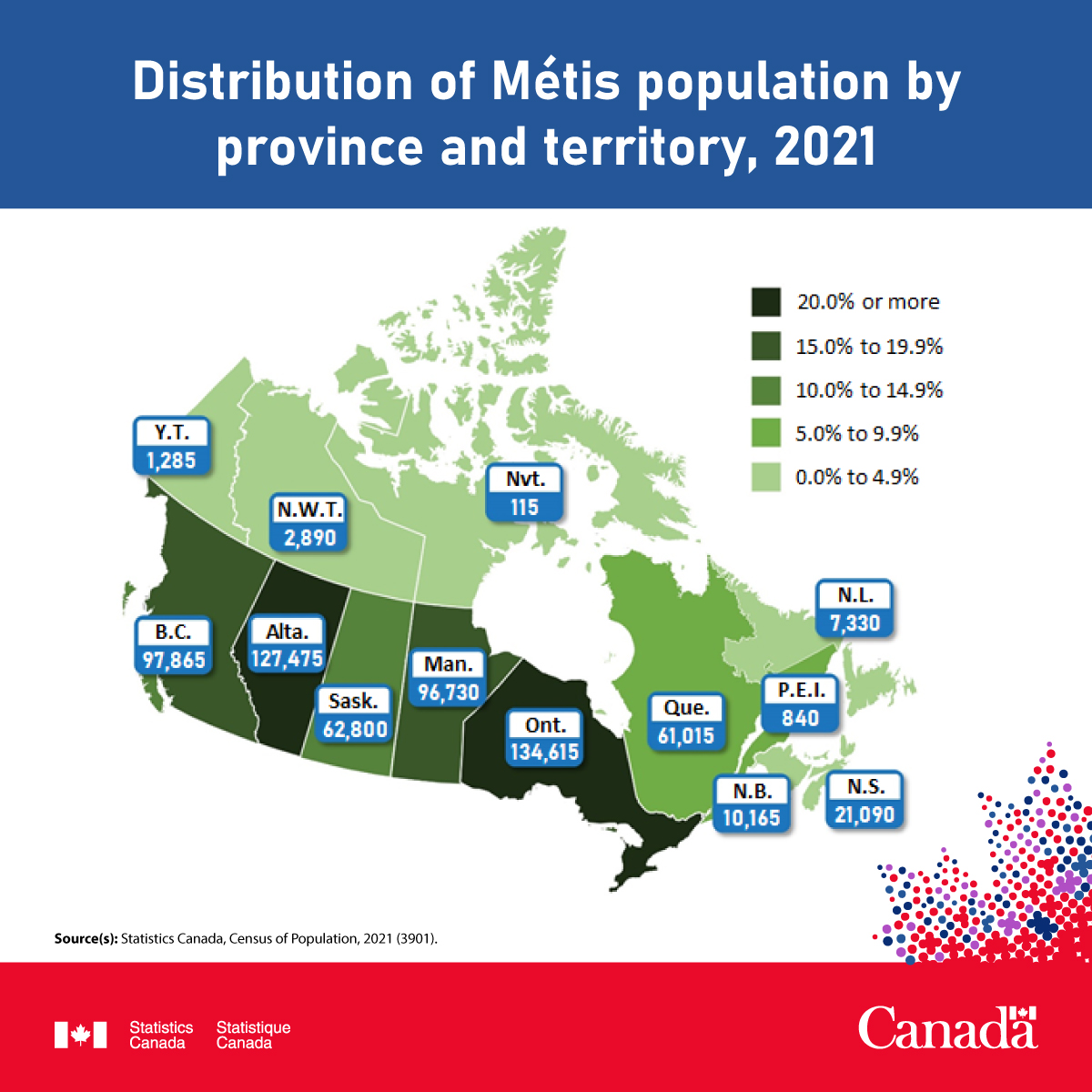
Alt text / description - Post 5 image
Distribution of Métis population by province and territory, 2021
This is a map of Canada by province and territory, showing the number and distribution of Métis.
In Alberta and Ontario, the proportion of Métis was 20.0% or higher. In British Columbia and Manitoba, it was 15.0% to 19.9%. In Saskatchewan, it was 10.0% to 14.9%, and in Quebec, 5.0% to 9.9%. In Newfoundland and Labrador, Prince Edward Island, Nova Scotia, New Brunswick, Yukon, the Northwest Territories, and Nunavut, the proportion of Métis was 0.0% to 4.9%.
For the provinces and territories, the numbers of Métis are presented as follows: Newfoundland and Labrador at 7,330; Prince Edward Island at 840; Nova Scotia at 21,090; New Brunswick at 10,165; Quebec at 61,015; Ontario at 134,615; Manitoba at 96,730; Saskatchewan at 62,800; Alberta at 127,475; British Columbia at 97,865; Yukon at 1,285; the Northwest Territories at 2,890; and Nunavut at 115.
Source(s): Census of Population, 2021 (3901).
Suggested text:
The #2021Census counted 224,655 people reporting membership in a Métis organization or settlement.
Learn more about the Métis population in Canada: https://bit.ly/3BJNePq
Post 6
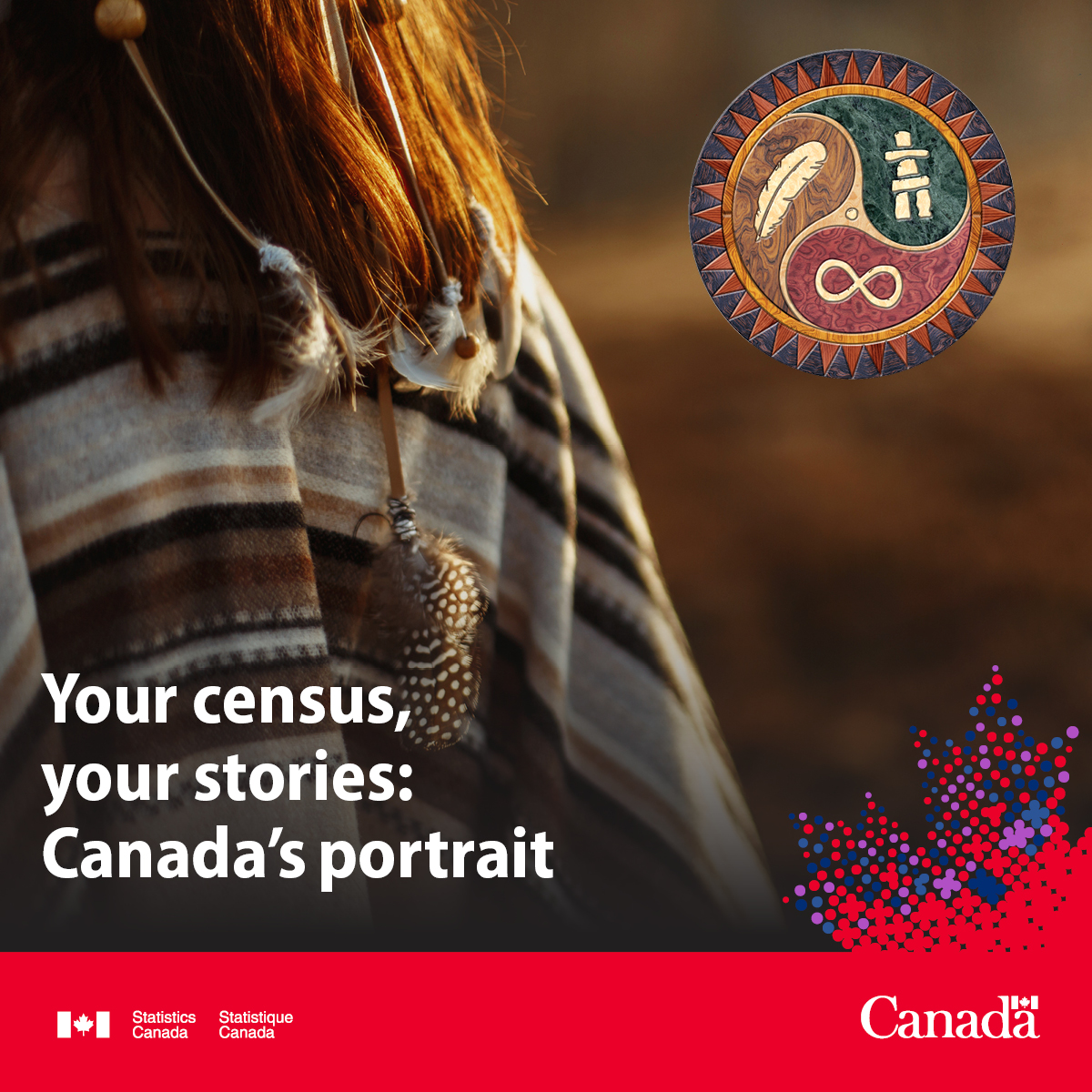
Suggested text:
The #2021Census counted 1.8 million #Indigenous people, now accounting for 5.0% of the total population in #Canada, up from 4.9% in 2016. To learn more: https://bit.ly/3BJNePq
Web images
Terms of use
See the terms of use for information on the approved use of official wordmarks, identifiers and content.
